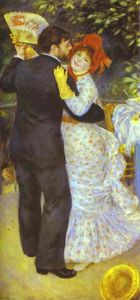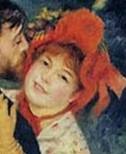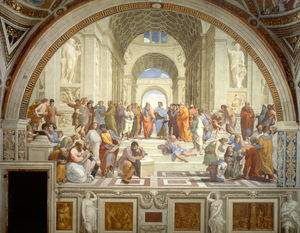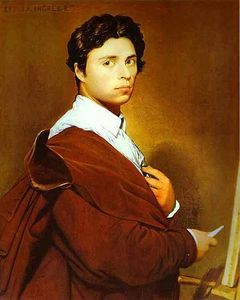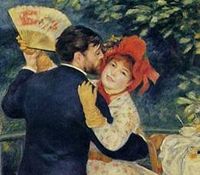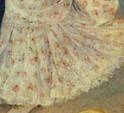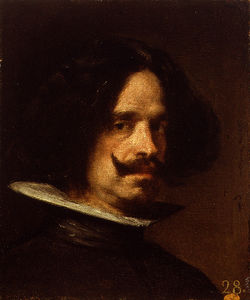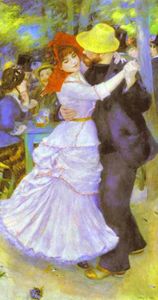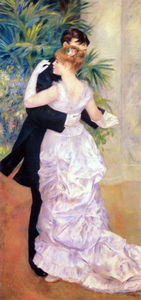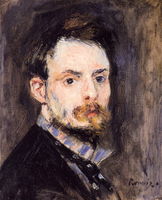Dance in the Country
- Date of Creation:
- 1883
- Alternative Names:
- The Country Dance / La danse a la champagne
- Height (cm):
- 180.00
- Length (cm):
- 90.00
- Medium:
- Oil
- Support:
- Canvas
- Subject:
- Figure
- Framed:
- No
- Art Movement:
- Impressionism
- Created by:
- Current Location:
- Paris, France
- Displayed at:
- Musee dÓrsay
- Owner:
- Musee dÓrsay
- Dance in the Country Page's Content
- Story / Theme
- Inspirations for the Work
- Analysis
- Critical Reception
- Related Paintings
- Artist
- Art Period
- Bibliography
Dance in the Country Story / Theme
Dance in the Country is also known as The Country Dance and La danse à la champagne. It was one in a set of three paintings; Dance in the City (La danse à la ville), Dance at Bougival (La danse à Bougival), and Dance in the Country (La danse à la champagne) to be commissioned by Paul Durand-Ruel, one of Renoir´s greatest supporters, in 1883.
Renoir´s contentment in his family life during this time was obvious in his art and, becoming more bourgeois, his Dance pictures honored this typical middle-class activity.
Dance in the Country was the only canvas in which Renoir painted the female - in this case his future wife, Aline Charigot - enjoying herself and showing a full smile. His mistrust of knowledgeable women was renowned and so it could be that he did not feel threatened by Aline, as she was a seamstress and a working class girl and thus decided to paint her with a full smile. In his first sketch of Dance in the Country there is very little detail and the woman´s identity was unknown. Yet, in the final painting Renoir depicts a very happy woman with a mouth curving upwards in a definite smile.
In his later works, Renoir put great emphasis on women in his paintings. Renoir's biographers claim that he worked best when surrounded by women, as he could listen to them sing while working. It appears that his paintings and yearning for the company of women were suggestive of his general attitude towards the opposite sex and for him, women could serve as muses.
Dance in the Country appears to show a bourgeoisie couple having just finished dinner rising from their chairs spontaneously to dance to a familiar song, and their spontaneity is emphasized by the hat dropped in the foreground. Movement is portrayed through the couple´s body language and clothing, and it seems the dancers are immersed in their own thoughts and space.
Dance in the Country Inspirations for the Work
The Dance series paintings marked a change in Renoir's technique in the early 1880s and this decade is generally regarded as the most experimental of Renoir's entire career.
Following the Franco-Prussian war of 1870, Renoir and his associates founded the Impressionist School. They were greatly influenced by nature and their surroundings, and moved away from the sober colors of European art, adopting a style based on bright colors and spontaneity.
Growing increasingly frustrated with the direction Impressionism was taking, Renoir began looking to the past for fresh inspiration. A trip to Italy in 1881 exposed him to the works of Raphael and other masters of the Renaissance and this convinced him that he was on the wrong path. In a letter written upon returning home he said: "I will, I think, attain the grandeur and simplicity of the ancient painters [... ] so as a result of seeing the outside, I ended up seeing nothing but the great harmonies without taking any more notice of the petty details which extinguish the sun instead of making it burn brighter. "
During the next six years or so Renoir experimented with his art and his subsequent works demonstrated a more severe style and he tried to return to classicism. This time in Renoir's career is often referred to as his "Ingres period" because he focused on his drawing and accentuated the outlines of figures.
Dance in the Country was part of a set of three paintings; La danse à la ville, La danse à Bougival, and La danse à la campagne commissioned in 1883 by Paul Durand-Ruel, one of Renoir's greatest supporters.
Dance in the country is the only painting depicting a smiling woman which was very significant in Renoir's work. The woman's smiling face - modeled by Aline Charigot, Renoir's future wife - seems to show the artist's respect for her. At the time the artist created this canvas, it was generally believed that portraying models with a smile would result in a painting not being taken seriously. It was only in this particular canvas that Renoir painted his future wife enjoying herself and showing a full smile. This could be a reflection of Renoir's happy domestic life at this time; as a middle-aged man, he enjoyed a stable income and dedicated a great deal of time to his family, and his happiness was evident in his art.
Yet, many believe that given his mistrust of knowledgeable women, and the fact that his wife was a seamstress and a working class girl, she did not threaten his reputation and thus he allowed her to enjoy dancing with a smiling mouth.
Another inspiration for this painting was Renoir's bourgeois lifestyle, and his collection of Dance pictures are celebrations of this treasured middle-class pastime.
Dance in the Country Analysis
Renoir took great pleasure in painting his friends with sincerity and he depicted their facial features and body stances with great detail. Such paintings expressed energy and intimacy and by capturing special moments, they served as treasured nostalgic memories. Dance in the Country was one such painting and it was part of a set of three canvases that marked a change in Renoir's technique.
Composition:
The composition of Dance in the Country is typical of Renoir's flowing style but in contrast to his earlier works, all three of his Dance paintings have tighter compositions, and lines are used to direct the viewer's eye towards the couple at the center of the canvas.
Dance in the Country has a light composition and its figures are delicate. Movement is portrayed through the couples' body language and clothing and it appears that they are immersed in their own thoughts and space.
Color Palette:
Dance in the Country shows Renoir drawing accurately as well as adopting a simpler palette than in previous works. He admitted that this greater attention to drawing was the result of his need to change his technique following his trip to Italy.
In Dance in the Country Renoir paints Aline Charigot - his future wife - using warm colors and the light colors of her dress contrast with the darkness of the man's suit, forcing their images to the foreground. Renoir uses brush strokes up and around the couple's feet and at the hem of Aline's bright dress, where movement is depicted through the swooshing motion.
Lighting:
Renoir's nuances of light and shadow come together to create a warm, sensual painting. Famous for his vibrant light and saturated color, he depicts the couple in Dance in the Country intimately and honestly. In true Impressionist style, Renoir suggests the details of this scene through liberally brushed touches of color, so that the couple softly fuses with one another and their surroundings.
Dance in the Country Critical Reception
Unlike many other artists Renoir's view of modern life was reflected in his oeuvre which was solely based on joy and pleasure. This dedication to all things pleasant has made Renoir the least fashionable Impressionist painter among critics and art historians alike but a hugely popular painter nonetheless.
Contemporary Reception:
Like many of his works during this time, Dance in the Country demonstrated a new classical technique inspired by Renoir's visit to Italy and exposure to the works of Raphael, Velazquez, and Rubens. The notable differences in this and other paintings at this time resulted in them being grouped together under the title of the "Ingres" period, reflecting their slight similarity to the technique of Ingres. This period is also known as Renoir's "harsh" or "dry" period.
During this "Ingres" period, which lasted for approximately six years, Renoir's art became more severe in its style and he attempted to return to more classical art, with its pure and majestic approach. His drawing became more defined and his use of light more harmonious. Renoir met with disapproval due to the fact that he was not part of any particular movement and his work was not well-received by many critics.
It seems that in Dance in the country Renoir begins to show more respect for the woman by allowing her to smile. At the time Renoir created this canvas, it was generally believed that portraying models with a smile would result in a painting not being taken seriously. This was the only canvas in which Renoir painted the female - his future wife - enjoying herself and showing a full smile.
Posthumous Reception:
Renoir did not completely disregard Impressionism as he retained a luminous palette. The main change to his works was the emphasis on volume, form, contours, and lines rather than on color and brush stroke. However, the works from this period, including paintings such as Dance in the City, are often considered among the least successful of Renoir's later offerings.
Modern Day Reception:
The Dance series paintings marked a change in Renoir's technique in the early 1880s and this decade is generally regarded as the most experimental of Renoir's entire career. A romantic and energetic painting, Dance in the country is one of Renoir's most treasured works of art.
Dance in the Country Related Paintings
Dance in the Country Artist
Renoir is an artist best known for his depictions of pleasant scenes, and curvy women. As a young painter he was influenced by a number of artists and artistic periods and this resulted in him developing an original technique which earned him his reputation as a 'pure impressionist. '
Renoir painted landscapes, portraits, still life, and modern life. He experimented with new methods throughout his career and dedicated his life to his art.
He was the first Impressionist to break away from the movement's ultramodern direction, yet many feel Renoir remained the purest of all the Impressionist painters throughout his career. He made several thousand paintings and their sensuality made his works some of the most famous and frequently-reproduced in the history of art.
Dance in the Country was part of a set of three that marked a change in Renoir's technique in the early 1880s and it went on to influence his art throughout the rest of that decade, which proved to be the most experimental of his career.
Dance in the Country Art Period
Renoir, together with his classmates Monet, Sisley, and Bazille established the Impressionist movement. Taking art in a new direction, these young artists experimented with new techniques and were considered radicals of their time because they broke the rules of traditional forms of painting, and worked outside of the studio.
Although Impressionism in France began when several other painters were experimenting with plein-air painting, Renoir and his peers developed new techniques that defined the movement; their art was immediate, and it portrayed movement with sincere compositions and vivid colors.
Rejected by the Salon, they displayed their works in private exhibitions and gained support for their distinct, modern paintings. Their works were easily identifiable by their use of bright colors, visible brush strokes, and emphasis on light. Their style depicted subjects and landscapes naturally. The public welcomed this original vision although art critics did not.
The emergence of Impressionism inspired many other artists of the time and throughout the 19th century and led the way for a variety of other movements, including Neo-impressionism, Post-impressionism, Fauvism, and Cubism.
Dance in the Country Bibliography
Many books have been written about Renoir and this famous painting. Below are a bibliography and a selection of recommended works about this fascinating art genre and one of its leading figures.
Bibliography:
• Renoir: A Master of Impressionism
Gerhard Gruitrooy (2009)
• Renoir, My Father
Jean Renoir (1964)
Recommended reading:
• Impressionism: Art, Leisure, and Parisian Society
Professor Robert L. Herbert et al (1991)
• Impressionism: Origins, Practice, Reception
Belinda Thomson (2000)
• The Private Lives of the Impressionists
Sue Roe (2007)

